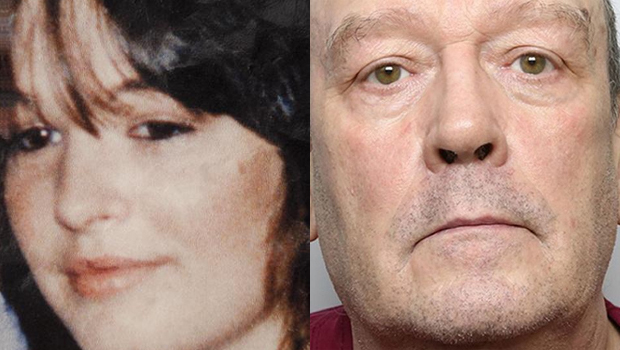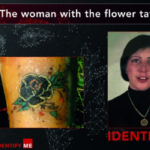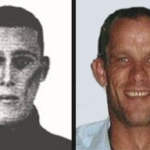The Beast of Bramley 2: The Scottish Cases
by Tim Hicks and Chris Clark
~~~~~
Introduction
The authors have studied West Yorkshire murderer and rapist John Taylor and have written two articles on the crimes that have been attributed to him, but for which he has not been convicted.
The first article can be read here.
The authors believe this is the best study from open sources currently available to the public.
This article takes a different style to our previous articles, focussing on the human cost and the effect of a murder on the victim’s family.
Ann Ballentine (1987)
Ann Ballentine (pictured above/left) was 20. Her naked and bound body was discovered in the canal at Fountainbridge wrapped in a carpet on January 21, 1987. The case is still open and recently her brother Alan appealed for Chris’s assessment that Taylor should be a suspect should be investigated. Edinburgh Evening News article here.
Police Scotland gave us this media statement:
“Detective Chief Inspector David Pinkney said: “The murder of Ann Ballantine was fully investigated by the then Lothian and Borders Police, with a report being sent to the Procurator Fiscal. Following upon consideration by Crown Counsel no further enquiries were instructed. Periodic reviews have been carried out in respect of this crime however it remains an unresolved case.”
“It is the view of Police Scotland that these cases are never closed and the passage of time is no barrier to the investigation of unresolved homicide cases. All unresolved homicides are kept under review and should new information come to light it will be acted upon.
Chris now covers the case in detail. He has adopted a different style, to show the human cost of a murder and the impact on the victim’s family.
During November 1986 20 year old Ann Ballantine, a pretty lively girl who had a flat in Yeaman Place near Dalry Road, Edinburgh, disappeared from home she had gone missing in November 17, 1986, after visiting her mum. Over 2 months later on 21 January 1987 her naked body was found floating in the Union Canal under Walker Bridge 200 yards from her home, very unusually she had been dumped wrapped in a carpet. She had been bound hand and foot and asphyxiated using a ligature and most unusually her body had been stored for weeks elsewhere before being dumped only a matter of days before she was found. There is a strong suggestion that whoever killed Ann removed some of her belongings from her flat before locking it.
The seconds ticked away to midnight and Christmas. It was usually such a happy time in that home, a time for family. But not that year – a young daughter was missing. They had last seen her a few weeks before, in November 1986. The beautiful, raven-haired, young woman was her usual, upbeat, smiling self. But that had been four weeks before and now they were worried. Ann Ballantine didn’t make it to her parents’ home on Christmas Day either. Her mother and father sat with their younger son and daughter and tried to be as cheery as possible. But they were worried. Very worried.
Ann Ballantine lived alone. She was 20 years old and an independent spirit. Not the type of daughter her parents would see every day. But they saw her often enough and now she hadn’t been round for such a long time. A few days after that last meeting, they’d asked her friends if they’d seen her. Sure enough, some had spotted her around her home city of Edinburgh. But five days later a pal phoned Ann’s parents to say she hadn’t turned up for a meeting. That wasn’t like their Ann at all. Then they really started to worry. A few weeks before, Ann had split up with her boyfriend, Joe Burden. Yet she hadn’t been in the doldrums. She was upbeat, full of plans. She’d moved into her own flat in Yeaman Place near Dalry Road.

Graham and Isobel Ballentine with a portrait of Ann
Her parents, Graham and Isobel, went round and knocked on the door. Receiving no reply, they slipped notes and some money through the letterbox. “Phone us, even if you’re skint,” they appealed. No phone call was received. That wasn’t like Ann at all. She cared for people – especially her family. Ann might well be broke. She was unemployed and money was tight. But she did work as a volunteer in the Canongate Youth Project and with other kids, especially those with disabilities. She might have loved loud, heavy metal music, hung around The Venue club in Calton Road and had some fierce-looking biker pals, but Ann loved life and children. As Isobel and Graham’s miserable Christmas turned into Boxing Day, there was still no sign of her. That’s when they made the big decision – go to the cops. The police wouldn’t normally treat a missing 20-year-old as urgent. People move away without telling their relatives for 101 reasons.
But Ann had already been missing for four weeks. A beautiful young woman, living on her own, who had made no attempt to contact her family to whom she was so close. The police pulled out all the stops. Gaining access to her flat, the police could see there was no sign of a break-in or any struggle. It looked just as it would have done if Ann had popped out for a few hours but her parents noticed something strange. Some things were missing. A black leather jerkin, a brass petrol lighter with her initials engraved, a camera, photo album and a black shoulder bag. It was a strange collection – unlikely to be considered as valuable loot by a burglar and hardly the collection Ann would pack if she were going away for a while. The missing items were interesting but no more than that.
As the police trawled the city streets, tracking down Ann’s friends and her ex-boyfriend, day after day they came up with the same answer – Ann had disappeared off the face of the Earth. As the weeks crawled by, her family’s despair must have sunk to new depths. Then one day Graham Ballantine took his car to a garage and heard news that shook his very soul. Graham went home immediately to see his wife. At the garage, he’d been told that three men had spotted a young woman’s body in the freezing waters of the nearby Union Canal.
Police crammed the area and wouldn’t let anyone near the site. Could it be their Ann? Soon came the dread knock on their door. It was the police with the worst of news. Ann’s naked body had been found wrapped in a carpet in the canal. As her distraught mother wept, the police went about the business of finding out all they could about Ann’s death. Ann had been strangled – always a worrying sign for the police. Strangulation takes time and effort. The killer watches the victim first kick out and struggle, then slowly ebb to unconsciousness and death.
Many stranglers get a kick out of killing, a taste for it. Ann’s murderer might well strike again. The forensic scientists came up with intriguing information. Though Ann had been dead for almost two months, she had only been in the canal for a few days. Her murderer must have stored the body for all that time before slipping her into the canal. What type of cold killer could do that?
Her poor parents weren’t even allowed to see their daughter, so advanced was the decomposition. The police were certain that Ann had been raped but the length of time between her death and being found meant that much evidence had been destroyed. Police frogmen dragged the dirty waters of the canal for days and uniformed officers walked every inch of the area. Others searched the warehouses, disused garages and derelict buildings. Still they didn’t find where Ann might have lain. Nor did they find that strange list of items missing from her flat. A photo album, clothes and that brass lighter with her initials – personal items.
Had the killer collected mementos? A strangler who liked to keep some personal memory of his victims? Was a serial sex killer on the prowl in Edinburgh? The months rolled on and still no further clues emerged. Eventually Isobel and Graham were allowed to lay their beautiful daughter to rest. There was just one condition – she had to be buried rather than cremated, in case she had to be exhumed in the future. Yet shortly before her death, Ann had said to her mother that she couldn’t stand the thought of lying in the ground in a coffin. She hated spiders, worms and every sort of bug and wanted to be cremated. Even after so much pain, her parents were denied the opportunity to grant her last wish.
The years rolled painfully by and there was no sign of Ann’s killer playing his sick and deadly game on other young women. Police became more and more convinced that whoever her killer was knew her well. An everyday man who afterwards had gone about his business, lived his life as if nothing had happened.
Police Scotland have refused to give up on Ann. A cold case team are reviewing the inquiry and forensic evidence is being re-examined. While forensic science and DNA have progressed so much over the past three decades, the truth is that much of the evidence will have deteriorated beyond use due to the time her body lay before discovery and those few days in the water. The carpet Ann was found in has been kept, though, and some cops are hopeful that fibre analysis will now prove to be useful.
During December 2015 I contacted Isobel Ballantyne and told her of my thoughts concerning who possibly had murdered her daughter (Taylor), however she has been convinced by Police Scotland that the man who murdered her and stored her body for several weeks was Ann’s estranged boyfriend. This is despite the fact that he did not drive or own a car and lived a 10-minute walk away from Ann’s flat and the part of the canal where she was found dumped. So if he was her killer, he would have had to have carried her body (doing a Ted Bundy) a half mile through the streets of Edinburgh. Also the police had interviewed him at his flat where there was no trace of Ann forensically.
Monday 3rd July 2017; the mother of the young woman brutally murdered in the capital says she still holds out hope for justice 30 years later. Ann Ballantine was just 20 when her body was discovered floating in the Union Canal. She had been strangled and dead for weeks before her killer got rid of the body. The find gripped the city with fear – could there be a crazed killer on the loose? But there were to be no further slayings, the police ultimately drew a blank and Ann’s family were left to grieve alone. Now, 30 years on, Ann’s family say they know who did it – and the realisation that her killer still walks free makes their grief rawer still. “It’s difficult knowing he’s about, it makes my blood boil,” says mum Isobel, 69. “He’s probably with his family and Ann is six-feet under. Why does he deserve that? I’m very bitter.” But how did it come to this? A fun-loving rock music fan snuffed out in her prime. “Ann was my first-born and I was only 18 but she was a good baby,” says Isobel. “She was such a happy child – a real happy-go-lucky kid.” Ann attended Broughton Primary before going on to Trinity School. She left home at 18 to pursue an independent life. She volunteered at the Canongate Youth Project for disadvantaged children. “She wanted to work with those less fortunate,” says Isobel. “She got her own flat in Fountain bridge but would come back every week because she didn’t have a washing machine so she’d come back to do her washing, hang it up to dry and take some food, like kids do when they move out.” Younger sister Grace, 48, recalls a typical sibling rivalry. “Me and my sister used to fight like cat and dog when she lived at home, like sisters do. But when she moved out, we were really close, I miss her terribly,” adds Grace, who still wears Ann’s ring on a chain around her neck.
Everywhere around the comfortable living room of the family’s Bonnington home are poignant reminders of Ann. Her last photo gazes down from a bookcase, a pencil portrait commissioned while in Spain on holiday, a footrest full of newspaper clippings. The last time Isobel saw her daughter was on November 18, 1986, after Ann had visited a family friend in hospital. “She was just her normal self and I asked her if she’d still be down for Christmas,” recalls Isobel. “She loved Christmas and would always come home on Christmas Eve and stay the night. We’d open one present on Christmas Eve.” Unbeknownst to Isobel, that chat would be her last with Ann as her daughter vanished, signalling a downward spiral of despair. “She’d been missing for so long,” says Isobel. “I’d been up to the flat three or four times putting a note through the door with some money – £5 and a 5p asking her to phone me.” Police spoke to Ann’s ex-fiancé, family and friends but there was no trace of her. The Ballantines, meanwhile, grew more fearful with every passing day.
It was to be the front page of the Evening News that brought the grim reality home to Isobel and husband Graham, now 70.“It was just another ordinary morning and Graham said he was going up to the garage with the car,” says Isobel. “He went and my brother phoned and asked me if I’d seen the paper yet – it said a body had been found in the Union Canal, the body of a young woman. Graham came back and said he didn’t know what was going on but there was police everywhere. I told him a body had been found and he said Oh my God’. Those few days were a living hell, not knowing if it was her. We got ready for it and prepared for the worst. I got friends and relatives, as many people as I could pack into the house.” Grace recalls: “I got a taxi back home and ran into the back bedroom. I can’t even remember who came to ask me if I was coming through to sit with everyone. “But I just said I don’t need anyone to tell me it’s my sister. I just had a feeling it was her, I just knew”. Isobel adds: “After a few days they phoned us to tell us it was Ann.
“It was like living in a nightmare from which we couldn’t wake up.” Ann’s body was so badly decomposed, she was identified by dental records and a distinctive scar on her head. Grace says: “We never got to say goodbye because we weren’t allowed to see the body but we did get a lock of her hair and we still have it.” A heavy metal fan, Ann had a ticket to an upcoming Alice Cooper concert in Edinburgh when she disappeared. In a cruel twist of fate, Isobel later met the rock fan who would have been sitting next to Ann that night had she lived. “I was working in a restaurant on Rose Street with this guy who told me he was supposed to be sat next to her at the concert but the seat was empty.”
Police frogmen trawled the canal for clues and photographs were reportedly found scattered on a footpath near where Ann was found. A massive manhunt was launched. A number of items were found missing from Ann’s flat – a black leather jerkin, a brass petrol lighter engraved with her initials, a photo album, camera and black shoulder bag. Were these taken as mementoes by the murderer – adding weight to the serial killer theories? Or was Ann killed by someone she knew? There was initial hope of snaring the fiend – a group of workmen spotted a man dumping something in the canal. Police eventually came up with a suspect and sent a report to the procurator fiscal but there was insufficient evidence for a prosecution.
Isobel found solace in a London-based charity of parents of murdered children, before setting up an Edinburgh branch to help others like her. “I got a lot of comfort from talking to mothers who had lost their kids. I made a lot of nice friends. I used to go out and visit people who’d lost kids. It was hurtful but also uplifting to know you’re not on your own”. The investigation may have stalled but Ann’s family are convinced they know the killer’s identity. Graham said once: “We know who it is but we’re not allowed to say. He’s a sociopath, he has to be.” The family has a photograph of the man they suspect taken at a family party, looking at Ann with “pure evil” in his eyes. And then there are the last words of Ann herself. “Ann kept a diary and the last comment in it was ‘there’s somebody knocking at my door, I think I recognise the knock, I think it could be XXX,” says Isobel. “I just don’t know how he can live with himself. He kept her and dumped her body. If he’d found her in the flat, why couldn’t he of phoned the police anonymously,” she adds, the pain still there behind her eyes. Ann’s case is still officially open and is one of many being handled by Police Scotland’s specialist cold cases unit.
But the Ballantine’s are left to mark family landmarks without their beloved Ann. She would have turned 50 last September and the family made a pilgrimage to Moreton Hall Cemetery. “We went to the graveyard and I had a special wreath made up of dark purple roses which was her favourite colour,” says Isobel. Former Rowntree’s factory worker and care home handyman Graham was diagnosed with dementia five years ago and is now in nearby Letham Park Nursing Home. One of the toughest realities facing Ann’s family is that Graham will now never see her killer caught. Grace says: “He hoped and he prayed one of these days we’d see justice done. She missed me getting married. She missed me having kids. She was motherly and very family orientated but she never got to have kids. I’ve brought up all my kids to know who their aunt was.” For Grace, Christmas is particularly difficult: “I go into a room by myself and think about my sister for half-an-hour or so.” Isobel adds: “There’s not a day goes by when I don’t think about her and wish she was still her with us. We still hope for justice.”
Why Chris believes Taylor should be a suspect in the murder of Ann Ballentine:
- John Taylor was aged 30 in 1986 was a parcel delivery driver who visited Edinburgh and was a regular visitor to Glasgow where he sought prostitutes
- It has been alleged that he used a brothel in Glasgow and that his route there would have taken him within four hundred yards of her home.
- The body was wrapped in a covering
- The body had been bound hand and foot
- She had been asphyxiated using a ligature
- Her body had been stored for weeks elsewhere before being dumped only a matter of days before she was found
Far fetched? According to this 2003 Guardian article , by Martin Wainwright, Strathclyde Police Scotland investigated Taylor in connection with the killings of the following Glasgow prostitutes:
- Diane McInally (23), 1991
- Karen McGregor (26) 1993
- Leona McGovern (22) 1995
- Marjorie Roberts (34) 1995
- Tracey Wylde (21) 1997
- Alison Wallace (27) 2000
This article is focused on the murder of Anne Ballentine, so the authors pass no comment on the possibility that Taylor was the perpetrator of the above six murders.
Police Scotland Appeal for Assistance
“Detective Chief Inspector Dave Pinkney said:
All unresolved murders are continually reviewed for opportunities presented by new information or advances in forensic science which will be acted on. Police Scotland never considers cases closed and the passage of time is no barrier to the investigation of unresolved homicide cases.”
If anyone has any information in relation to these cases, please come forward and contact Police Scotland on 101 or Crimestoppers on 0800 555 111 – any new information will be thoroughly investigated.
The authors would like to thank the Police Scotland Corporate Communications Team for their help and co-operation in the writing of this article.













